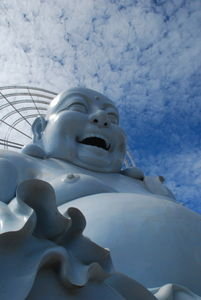Advertisement
Published: March 1st 2008

 Happy Buddha
Happy Buddha
Behind the Linh An Pagoda is the Happy Buddha, and you just couldn’t help but smile when looking at him. His face pretty much sums up our pleasant trip to Da Lat.There’s nothing like the freedom of the open road on a motorcycle: unobstructed scenery, clean air in your lungs, wind in your hair, hard rain cutting at your face…
Okay, despite the latter - and a bit of a numb ass - we took a one-day tour around Da Lat on the back of motorcycles, and it was a major highlight of our travels to date.
We were led by Huan and Hung of the ubiquitous Easy Riders, a group of freelance motorcycle tour guides with members in the thousands. Their knowledge of the sights and willingness to share everything we wanted to know about Vietnamese culture was refreshing and enlightening. We saw and learned so much on our tour that we got over the guilt of hardly leaving our room for three days (thanks to a fresh stock of cheap DVDs).
Overall, Da Lat and the surrounding area was beautiful. Located in the central highlands, the climate, geography and vegetation are similar to B.C. and we enjoyed the cooler weather and cleaner, thinner air. Aside from our one-day bike tour, we visited a few of the local sights by foot, including the massive central market. The big

 Easy Riders
Easy Riders
Hung and Huan, your friendly neighbourhood Easy Riders.ticket items were cold weather clothing, like toques, sweaters and winter jackets that were probably fashionable in 1999. Keep in mind the local daily highs still ranged between 20 to 26 degrees and dipped down to about 14 degrees in the evening.
We saw very few tourists and experienced very little hassle from the locals, who stared at, smiled at, and said hello to us everywhere we went. We liked Da Lat so much that we looked into the prospect of teaching jobs and discovered there is a new school being built and they need teachers badly. We’ll see what happens.
After Da Lat, we headed off to the coastal city of Nha Trang for four days, and we are now in Hoi An. Due to a lack of Internet access, we're a little behind on blog postings, but I will try to catch up over the next couple days.
Wishing you were here,
The Smiths
Advertisement
Tot: 0.125s; Tpl: 0.014s; cc: 8; qc: 23; dbt: 0.0958s; 1; m:domysql w:travelblog (10.17.0.13); sld: 1;
; mem: 1.1mb

 Happy Buddha
Happy Buddha
 Easy Riders
Easy Riders



































Auntie Marcia
non-member comment
Drinking my coffee....
a premium blend of Arabica and Robusta beans. I tried it as a sample in a grocery store, and when I learned it was from Vietnam, bought it.....just because. I giggled as I sipped it this morning, looking at the pic of you Marc, with the coffee beans. They may be the worlds second largest exporter now, but they just sold another pound because of the Smiths. Cheers!